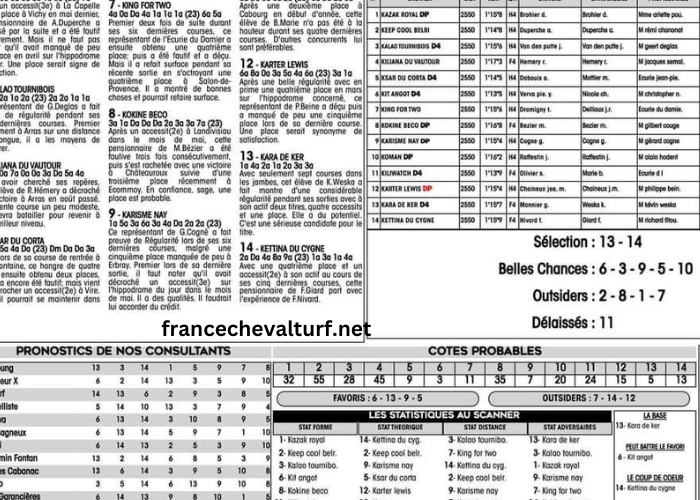Horse racing is a sport of strategy, skill, and knowledge, where success hinges on more than just luck. One of the key techniques used by serious bettors is the concept of Élimination Des Chevaux—eliminating horses from consideration to refine and enhance betting strategies. This article provides a comprehensive guide to mastering the art of Élimination Des Chevaux, offering expert strategies, tips, and insights to help you make informed betting decisions and improve your success in horse racing.
What is Élimination Des Chevaux?
Understanding Élimination Des Chevaux
Élimination Des Chevaux translates to “Elimination of Horses” in English. It refers to a strategic approach in horse racing betting where bettors systematically eliminate horses from their consideration to focus on the most promising contenders for their bets. This technique is used to simplify the betting process, increase the odds of selecting winners, and ultimately enhance the chances of winning bets.
Why Élimination Des Chevaux Matters
Eliminating horses is crucial for several reasons:
- Refines Focus: Helps narrow down the field to the most likely winners.
- Increases Odds: Improves the chances of picking the top horses.
- Optimizes Bets: Makes betting decisions more strategic and informed.
- Reduces Risk: Minimizes the impact of less likely contenders on your bets.
Key Components of Élimination Des Chevaux
To effectively eliminate horses and make strategic betting decisions, consider the following components:
1. Race Conditions Analysis
Analyzing the race conditions is the first step in the elimination process:
- Track Surface: Determine how the track surface (dirt, turf, synthetic) affects the horses’ performances.
- Weather Conditions: Assess the weather to understand how it might impact the race.
- Distance: Consider if the race distance is suitable for each horse’s strengths and weaknesses.
How to Analyze Race Conditions
- Research Track History: Look at the track’s historical data for insights into how conditions affect different horses.
- Check Weather Forecasts: Review weather forecasts for the day of the race.
- Evaluate Distance Suitability: Analyze horses’ past performances at similar distances.
2. Horse Form and Performance
Examining the horses’ recent form and performance is essential:
- Recent Races: Review the horses’ recent performances to gauge their current form.
- Past Wins and Losses: Look at their history of wins, losses, and placings.
- Consistency: Check for consistency in performance over time.
How to Evaluate Horse Form
- Review Race Records: Look at horses’ recent race results and performances.
- Analyze Recent Trends: Identify trends in their recent results.
- Check for Improvements: Look for signs of improvement or decline in form.
3. Jockey and Trainer Analysis
Jockeys and trainers play a significant role in a horse’s performance:
- Jockey Experience: Assess the jockey’s experience, skill level, and success rate.
- Trainer Success: Evaluate the trainer’s track record and success with similar horses.
- Recent Partnerships: Consider recent collaborations between the jockey and trainer.
How to Analyze Jockeys and Trainers
- Review Jockey Records: Check the jockey’s past performances and success rates.
- Evaluate Trainer Achievements: Look at the trainer’s history of success with horses.
- Examine Recent Results: Review recent results for the jockey-trainer combinations.
4. Competitor Analysis
Understanding the competition is crucial for eliminating horses:
- Competitor Form: Analyze the form and performance of other horses in the race.
- Strengths and Weaknesses: Identify the strengths and weaknesses of the competitors.
- Head-to-Head Records: Look at past matchups between the horses.
How to Analyze Competitors
- Research Competitor Performance: Look at theof other horses in the race.
- Assess Strengths and Weaknesses: Identify the key strengths and weaknesses of each competitor.
- Review Head-to-Head Results: Analyze previous races between the horses.
5. Odds and Betting Markets
Examining odds and betting markets helps with the elimination process:
- Odds Comparison: Compare odds from various bookmakers to find the best value.
- Market Trends: Analyze market trends and changes in odds.
- Public Perception: Consider the influence of public opinion on the odds.
How to Analyze Odds and Markets
- Compare Odds Across Bookmakers: Find the best odds for each horse.
- Observe Market Movements: Track changes in odds to identify betting trends.
- Assess Public Perception: Evaluate how public opinion affects the odds.
Strategies for Effective Élimination Des Chevaux
1. Develop a Systematic Approach
Create a structured approach for eliminating horses:
- Step-by-Step Process: Follow a systematic process for evaluating each horse.
- Checklists: Use checklists to ensure you consider all relevant factors.
- Record Keeping: Keep records of your analyses and decisions.
Steps for a Systematic Approach
- Analyze Race Conditions
- Review Horse Form and Performance
- Evaluate Jockey and Trainer
- Analyze Competitors
- Compare Odds and Markets
2. Use Advanced Tools and Resources
Leverage advanced tools and resources for better analyses:
- Betting Software: Use betting software for data analysis and predictions.
- Online Databases: Access online databases for comprehensive race information.
- Expert Reviews: Read expert reviews and analyses for additional insights.
Recommended Tools and Resources
- Betting Software: Software like Betfair Exchange or Racing Post.
- Online Databases: Websites like Equibase or At The Races.
- Expert Reviews: Follow expert reviews on platforms like Paddock Picks or Horse Racing Nation.
3. Stay Updated with Latest Information
Keep up with the latest information to inform your decisions:
- News Updates: Follow racing news for the latest updates on horses and races.
- Race Day Changes: Check for last-minute changes on race day.
- Social Media: Follow racing experts and analysts on social media.
How to Stay Updated
- Follow Racing News Websites: Stay informed with updates from news websites.
- Check Race Day Updates: Look for last-minute updates on race day.
- Follow Experts on Social Media: Engage with racing experts on platforms like Twitter or Facebook.
4. Apply Betting Strategies
Implement effective betting strategies to complement your elimination process:
- Value Betting: Look for bets with high value based on your analyses.
- Bankroll Management: Manage your betting funds to reduce risk.
- Diversification: Diversify your bets to spread risk and increase chances of success.
Effective Betting Strategies
- Value Betting: Identify bets that offer good value compared to the odds.
- Bankroll Management: Set and adhere to a betting budget.
- Diversification: Spread your bets across different races and horses.
5. Learn from Experience
Experience is a valuable teacher in horse racing:
- Review Your Bets: Analyze past betting experiences to identify what worked and what didn’t.
- Adjust Strategies: Refine your strategies based on past experiences.
- Learn from Others: Engage with other bettors to learn from their experiences.
How to Learn from Experience
- Review Past Bets: Reflect on past betting outcomes.
Adjust Based on Results: Make changes to your strategies as needed.



